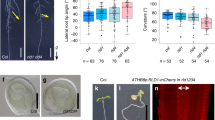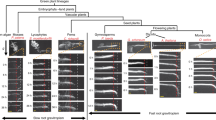Abstract
Plants are capable of orienting their root growth towards gravity in a process termed gravitropism, which is necessary for roots to grow into soil, for water and nutrient acquisition and to anchor plants. Here we show that root gravitropism depends on the novel protein, NEGATIVE GRAVITROPIC RESPONSE OF ROOTS (NGR). In both Medicago truncatula and Arabidopsis thaliana, loss of NGR reverses the direction of root gravitropism, resulting in roots growing upward.
This is a preview of subscription content, access via your institution
Access options
Subscribe to this journal
Receive 12 digital issues and online access to articles
$119.00 per year
only $9.92 per issue
Buy this article
- Purchase on Springer Link
- Instant access to full article PDF
Prices may be subject to local taxes which are calculated during checkout


Similar content being viewed by others
References
Darwin, C. & Darwin, F. (John Murray, 1880).
Chen, R. et al. Proc. Natl Acad. Sci. USA 95, 15112–15117 (1998).
Luschnig, C., Gaxiola, R. A., Grisafi, P. & Fink, G. R. Genes. Dev. 12, 2175–2187 (1998).
Muller, A. et al. EMBO J. 17, 6903–6911 (1998).
Dharmasiri, S. et al. Science 312, 1218–1220 (2006).
Marchant, A. et al. EMBO J. 18, 2066–2073 (1999).
Band, L. R. et al. Proc. Natl Acad. Sci. USA 109, 4668–4673 (2012).
Swarup, R. et al. Nat. Cell. Biol. 7, 1057–1065 (2005).
Chen, J. et al. Proc. Natl Acad. Sci. USA 107, 10754–10759 (2010).
Cheng, X. et al. New Phytol. 201, 1065–1076 (2014).
Nystedt, B. et al. Nature 497, 579–584 (2013).
Yoshihara, T., Spalding, E. P. & Iino, M. Plant J. 74, 267–279 (2013).
Uga, Y. et al. Nat. Genet. 45, 1097–1102 (2013).
Kenrick, P. & Strullu-Derrien, C. Plant Physiol. 166, 570–580 (2014).
Dong, Z. et al. Plant Physiol. 163, 1306–1322 (2013).
Yoshihara, T. & Iino, M. Plant Cell. Physiol. 48, 678–688 (2007).
Li, P. et al. Cell Res. 17, 402–410 (2007).
Benedito, V. A. et al. Plant J. 55, 504–513 (2008).
Tadege, M. et al. Plant Cell 23, 2125–2142 (2011).
Ge, L., Peng, J., Berbel, A., Madueno, F. & Chen, R. Plant Physiol. 164, 216–228 (2014).
Acknowledgements
We thank A. Laxmi and Y. Tang for the microarray experiments, G. Li for Medicago crossing, E. Blancaflor for microscopy, X. Cheng and J. Wen for reverse genetics screen. We thank K. Mysore for providing Medicago Tnt1 lines and ABRC for Arabidopsis T-DNA lines. Funding for Medicago genetic resources was provided by National Science Foundation (IOS-1127155) to R. C. Funding of this work was provided by The Samuel Roberts Noble Foundation, Inc.
Author information
Authors and Affiliations
Contributions
L.G. and R.C. designed and conducted experiments, collected data, performed data analyses and wrote the manuscript.
Corresponding author
Ethics declarations
Competing interests
The authors declare no competing financial interests.
Supplementary information
Supplementary Information
Supplementary Figures 1–10, Supplementary Tables 1–3. (PDF 5306 kb)
Supplementary Video 1
Root gravitropic responses of wild-type and atngr1,2,3 mutants. (MP4 12401 kb)
Supplementary Video 2
Root tip curvature responses of wild-type and atngr1,2,3 under gravistimulation. (MP4 3371 kb)
Rights and permissions
About this article
Cite this article
Ge, L., Chen, R. Negative gravitropism in plant roots. Nature Plants 2, 16155 (2016). https://doi.org/10.1038/nplants.2016.155
Received:
Accepted:
Published:
DOI: https://doi.org/10.1038/nplants.2016.155
This article is cited by
-
IGT/LAZY genes are differentially influenced by light and required for light-induced change to organ angle
BMC Biology (2024)
-
Research advances in plant root geotropism
Plant Growth Regulation (2024)
-
Antigravitropic PIN polarization maintains non-vertical growth in lateral roots
Nature Plants (2023)
-
Identification of LsLAZY1 gene in Leymus secalinus and validation of its function in Arabidopsis thaliana
Physiology and Molecular Biology of Plants (2023)
-
Identification of the PmWEEP locus controlling weeping traits in Prunus mume through an integrated genome-wide association study and quantitative trait locus mapping
Horticulture Research (2021)



